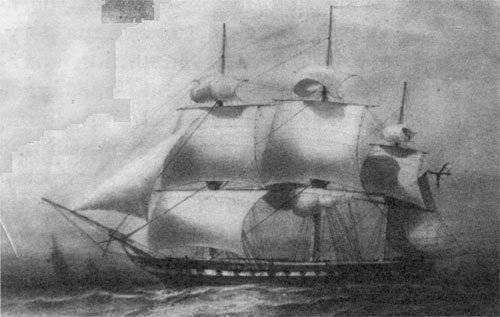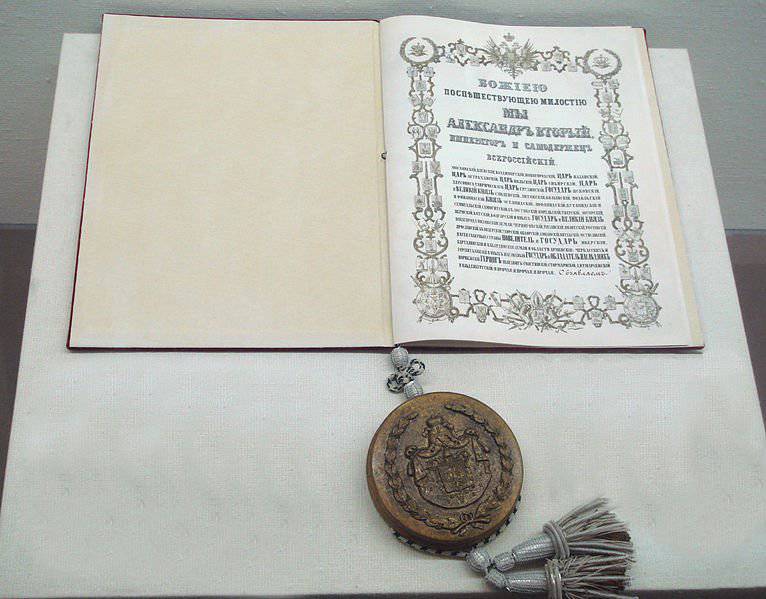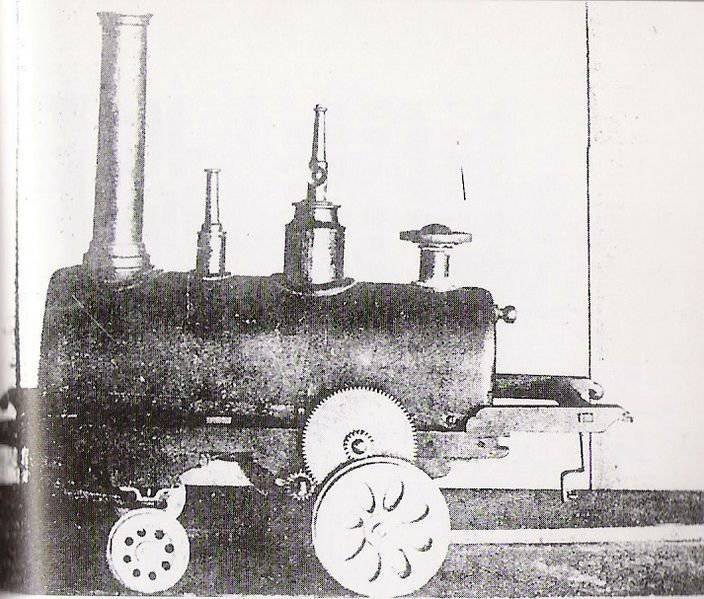Far Eastern question. How Russia vented with Japan. Part of 2
It should be noted that in the 19 century there was the possibility of establishing good-neighborly relations between Russia and Japan. Currently, after two Russian-Japanese wars, Japanese intervention in the Far East during the Civil War in Russia, an active alliance of Japan and with Hitler’s Germany and the USA, Tokyo’s demands for a so-called. "Northern Territories", it seems strange. However, it was Japan that could objectively supplement Russia in the East, as Germany could do in the West. To prevent this from happening, Russia and Japan were pushed together in roughly the same way as was done with Russia and Germany. Often in this “etching” the same figures flash, which diligently spoiled the Russian-German relations, like Witte.
By the middle of the 19 century, Russia had two attempts to establish relations with Japan: 1792-1793. Adam Laxman’s expedition has already established contact with this Eastern civilization, but due to a number of “dark” circumstances, Russia was unable to consolidate this success; Rezanov's journey to 1804-1805 It was frankly unsuccessful, the Japanese government banned Russian ships from pestering the Japanese shores. Having Russian America, Petersburg was obliged to systematically increase its presence in the Asia-Pacific region. This could lead to a shift from the dead center and Japanese affairs. Instead, Petersburg and Foreign Minister Karl Nesselrode (headed the foreign affairs agency from 1816 onwards - on 1856 onwards) actually gave initiative in the Pacific to the USA, England and other countries. Suffice it to say that in as many 18 years - from 1834 to 1852 a year, the entire 5 of Russian ships was sent to the waters of the Pacific Ocean.
Even the consolidation of the Amur Region for Russia actually did not happen thanks to the policy of official St. Petersburg and the Russian Foreign Ministry, but because of the selfless and independent actions of Gennady Nevelsky and the count Nikolai Muravyev who supports him. When 14 August 1850 of the year Nevelsky, to secure the mouth of the Amur for Russia, founded the Nicholas post and raised the Russian flag over it, the Council of Ministers, at the suggestion of Nesselrode, decided to bring Nevelskoy to a military court as a harmful person and "pushing the Fatherland to imminent danger." Saved the brave traveler personal audience Muravyov and Emperor Nicholas. The sovereign of the governor and the captain rewarded and said: “Where the Russian flag is raised once, it should not be lowered”. Unfortunately, this principle will be violated already by Alexander II and Grand Duke Constantine, who will lower the Russian flag over Russian America.
The main opponents of the “Far Eastern adventures” were the Ministry of Finance and the Ministry of Foreign Affairs. Nesselrode most feared the "displeasure of Europe," primarily England. This view of the opinion of the West "hacked" many useful activities that in the future led to the prosperity of Russia and its leadership in the Asia-Pacific region.
However, even heavy Nikolaev Russia saw the need to establish official relations with Japan. In 1843, Vice Admiral Evfimy (Efim) Vasilyevich Putiatin, a famous traveler and diplomat, developed a plan for organizing an expedition to the eastern maritime borders of China and Japan. In a memo addressed to the sovereign, Putyatin wisely noted that Russia has the need to explore our eastern border with China, search for a “trustworthy port”, explore the bay between the mainland and Sakhalin and make a new attempt to open relations with Japan. Emperor Nicholas I, despite the opposition of the Foreign Minister Count Nesselrode, who said “about the possibility of a break with China, about Europe’s displeasure, especially the British, in case of any vigorous actions on our part”, ordered the expedition to be equipped. However, Nesselrode was supported by Finance Minister EF Kankrin, who spoke of the large expenditures on the journey, also feared complications with China and the harm of “Kyakhta trade”, the expedition was postponed. True, a small brig "Konstantin" was sent under the command of Lieutenant Gavrilov, but he could not complete the task. A special committee chaired by Foreign Minister Nesselrode and with the participation of the War Minister Count Chernyshev, Quartermaster General Berg, and others immediately decided to recognize the Amur Basin as belonging to China and abandon it forever. ” How can you not remember Stalin with his "You are a fool or an enemy." Only Nevelsky and Muravyov were able to reverse this negative trend. The huge Amur region still became Russian.
Putiatin did not forget his ideas about traveling to Japan. In 1852, the government returned to the idea of opening diplomatic relations with Japan. In addition, data were obtained on the preparation of the squadron by the Americans under the leadership of Matthew Perry. In addition to Vice Admiral Putyatin, the expedition included: a trade department official, secretary of Putyatin, writer I. A. Goncharov, official, expert on Chinese and Korean languages I. A. Goshkevich, Alexander Mozhaisky (the future rear admiral and creator of the first Russian aircraft) , scholar-orientalist and archimandrite Avvakuum. They set off on a 52-gun frigate "Pallas" commanded by Captain I. S. Unkovsky. Putyatin had an order to seek the discovery of Japan by exclusively peaceful methods.

Frigate "Pallada".
October 7 The 1852 of the year the frigate set off, he left Kronstadt. The route lay around Africa, across the Atlantic, Indian and Pacific Oceans. During the trip, the ship's hull was shaken by the ocean passage, the Pallas hit two typhoons (in the Indian Ocean and Hong Kong). Therefore, from Kronstadt sent a second 52-gun frigate "Diana" under the command of S. S. Lesovsky. He walked through Cape Horn. 12 August 1853 of the year “Pallada” arrived at the port of Nagasaki, a month after the first visit of the “black ships” of Perry. However, Japanese officials accepted the letter of Count Nesselrode to the shogun only on September 9 1853 of the year. Apparently, the expedition had to send a more representative, following the example of the Americans. During a visit to Nagasaki, Putyatin showed the Japanese inventors the effect of a steam engine, which helped Hisasige Tanaka to subsequently create the first Japanese steam locomotive.
Evfimy proposed that Japanese officials establish trade relations and draw the line between the Russian and Japanese possessions north of Japan. Seeing that the Japanese were holding up negotiations, Putiatin decided to visit the Philippines, then Korea, to reconnoiter the east coast of Primorye. The Russian expedition discovered the gulfs of Posyet, Olga and the island of Rimsky-Korsakov. 11 July 1854, the frigate “Diana” arrived in the Far East, on which Putiatin set off for Japan for the second time. The frigate "Pallada" had to be towed to Konstantinovskaya Bay of the Imperial Harbor (Soviet harbor), where it was flooded in 1856 year.
22 November 1854 of the year “Diana” arrived at the port of Shimoda, where negotiations began a month later. Literally a day after the start of negotiations - December 23 there was a strong earthquake and tsunami. Russian sailors helped the local population. The Russian frigate was badly damaged, and at the beginning of 1855 of the year, during transportation to the repair site, sank. 7 February 1855 The Vice Admiral E. V. Putiatin and Tosiakira Kawaji signed the first friendship and trade treaty between Russia and Japan (Simodsky Treaty) in the temple of Gyokusendzi. The treatise consisted of 9 articles. Between the two powers was established "permanent peace and sincere friendship." Three ports were opened for Russian ships - Hakodate, Nagasaki and Shimoda. They allowed limited trade, under the supervision of Japanese officials. A Russian consul was appointed to Japan - he was Joseph Goshkevich (in 1858 - 1865, the consul of the Russian Empire in Hakodate).
Already in this contract were laid controversial points. Putyatin, despite his services to the Fatherland, clearly made a blunder. It is necessary to take into account that at this moment Japan was an “outdated” power, which lagged behind the advanced countries for centuries in technological terms. Russia was among the world leaders. We must not forget the shock of the Japanese, which was caused by the demonstration of the power of the American squadron. The moment was extremely convenient for securing Sakhalin and all the Kuril Islands to Russia. However, Putyatin for some reason agreed that Sakhalin is an unseparated demilitarized zone, a joint possession of the two powers. Kuril Islands north of about. Iturup was declared possession of Russia, and the Japanese were withdrawing part of the Kuriles — Iturup, Kunashir, Shikotan, and the group of Habomai islands. As a result, the Shimoda treatise became a document to which Japanese politicians still refer, raising the question of the territorial identity of the Kuril Islands. It was a clear and gross mistake of Russian diplomats. Perhaps they were influenced by the Crimean War, which undermined the authority of the Russian Empire. However, this does not justify them, Japan had no relation to this war, and had no opportunity to oppose the accession to Russia of all the Kurils and Sakhalin. It is also necessary to take into account the initial mistake of St. Petersburg - it was necessary to send not one frigate, but a detachment (squadron) from several ships on which it was necessary to bring industrial products of Russia, pictures, photo albums about Russia to give an idea of its stories and power. Of course, it was impossible to follow the example of the Americans and behave aggressively. But it was necessary to show the strength of Russia. Just demands had to be supported by the visible power of the Russian Empire.
It should be noted that, in general, Russian sailors in Japan showed a difference between the Russian national character and the West European, American one. After a natural disaster, the crew, who himself lost the ship, helped the local population. During this expedition began the cooperation of Japan and Russia in the field of science and technology. So, Russian helped with the workers and materials for the construction of the vessel. This was the first Japanese experience in building a European-style ship. On April 14, the schooner Heda was launched and on April 26 the Russians sailed home. Following the model of this schooner, the Japanese built several more ships. The Russians later handed over to the Japanese and Hed, along with scientific instruments and 52 guns from a sunken frigate.
In 1857-1858 Putiatin visited Japan twice and made additional agreements that gave Russian merchants additional benefits in trade, provided a more convenient port for Russian ships instead of Shimoda, allowed Russians to come by themselves or with their families "for temporary or permanent residence", permission was granted to open in Japan Orthodox Church. On the whole, these were positive changes, but Petersburg was more concerned with trade issues than with issues of changing the territorial land survey unprofitable for Russia to the north of Japan.
Unfortunately, this was not the beginning of a fruitful cooperation and union between Japan and Russia. Japan preferred orientation to a tougher and more determined West. Petersburg continued to make mistakes in relation to Japan. The government of Alexander II in general broke the record of stupidity in its Far Eastern policy. The Tsar and his brother, Grand Duke Konstantin, “liberated” Russia from Russian America in 1867, the national interests of the state in the Asia-Pacific region were dealt a heavy blow. Soon he “liberated” Russia from the Kuriles. 25 April (7 May) 1875 of the year in St. Petersburg was an agreement between Russia and Japan. According to him, Japan “refused” Sakhalin - it never belonged to it. Even in the times of Rezanov, the natives of Sakhalin, the Ainu, said: "Sakhalin is the land of the Ainu, there is no Japanese land on Sakhalin ...". They did not object to Russian citizenship. But in the “exchange” Russia gave Japan all 18 of the Kuril Islands.
Thus, from the very beginning, fundamental mistakes were made in relations between Russia and Japan, which served as the basis for more than a century of hostility. On the part of St. Petersburg was manifested stupidity, in a mixture of stupid mistakes and adventures in the field of American, Korean and Chinese politics. From the side of Japan - stupid samurai arrogance in combination with the same adventures in Korea, China and Russia.

St. Petersburg Treaty of 1875 (Archive of the Ministry of Foreign Affairs of Japan)
Striding wide. Japan successes in the Far East
The capitalist start of Japan was more than impressive. In 1872, the first Japanese railway connected Edo (Tokyo) with the port of Yokohama. In 1873, the foundation was laid for modern metallurgy - a plant near the Kamaishi iron mines in Iwate Prefecture. True, this first experiment was unsuccessful; ten years later, the plant was closed. But in 1901, the largest state metallurgical plant of Yavat earned. Japan increased its tonnage from 1891 to 1907 fleet 704% (!). For comparison, in the same period, the UK increased the tonnage of its merchant fleet by 91%, France - by 49%, the USA - by 217%, Germany - by 222%. It is clear that in absolute figures (611 thousand register tons by 1907), Japan was still far behind the great powers, England 16 times, Germany 3,5 times, the United States 2 times. But Japan has already overtaken Italy and overtook France. In the late 1880s, in Japan, the telegraph network was virtually zero, after ten years the country already had almost 3 thousand km of telegraph lines, and by 1908 more than 8 thousand km (in Italy there were 2 thousand). In 1893, Japan produced the first domestic steam locomotive. In 1909, Japanese savings banks had 8 million depositors (English - 11 million). The economic growth rate and the transition of a large country to a qualitatively new life and a new level of sovereign power were still unprecedented for the world. Only the Stalinist USSR will surpass Japan in the pace of change, but this will happen later.
Interestingly, in this tumultuous era in Japan, no particular, one national leader has emerged. In Japan, in the "Meiji era" there were bright and energetic figures, but there were a lot of them. Among them were Tosimichi Okubo and Takayoshi Kido - they prepared and implemented an administrative reform in Japan, the author of the constitution Hirobumi Ito. Most of them were young people, before their eyes Japan was “opened up” and began to humiliate. And they began to create a new Japan, selflessly, with full dedication of strength and energy. They wanted to master the knowledge and skills of Europeans and to equal themselves with them. They had to overcome serious internal resistance of conservative forces, this actually resulted in a civil war. It can be safely blamed on the West, since it was the Americans and Europeans who caused a split in Japanese society. Japan had to overcome the lag not in a gradual, evolutionary way, but in a revolutionary jerk. Many reformers paid for it with lives. 14 May 1878, a group of disgruntled samurai killed Okubo Tosimichi.

The first Japanese steam engine built in Hisasige Tanaka’s 1853, modeled on the machine installed on the Pallada.
Japan in this era was headed by active, courageous people who led Japan to victories and sovereign power. It is clear that we can not have good feelings towards them, for quite obvious reasons. However, their biographies and deeds cause respect. They opened a really great future for Japan. And with the more intelligent policies of St. Petersburg, Russia and Japan together could lead the region to prosperity and stability.
In relation to Korea, the Japanese behaved in much the same way as Commodore Perry behaved in relation to Japan. In 1876, the Japanese achieved the opening of the important port of Fusan for their trade, and in 1880, Genzan and Chemulpo. Korea was overrun by Japanese traders, military men, all sorts of adventurers who fished in the "muddy water" of an "open" country. They deceived, robbed Koreans, took part in all sorts of internal intrigues at the Korean court, sought the predominant influence at the courts of the Korean feudal lords. Such brazen pressure twice led to an open rebellion - in 1882 and 1884.
To be continued ...
Information